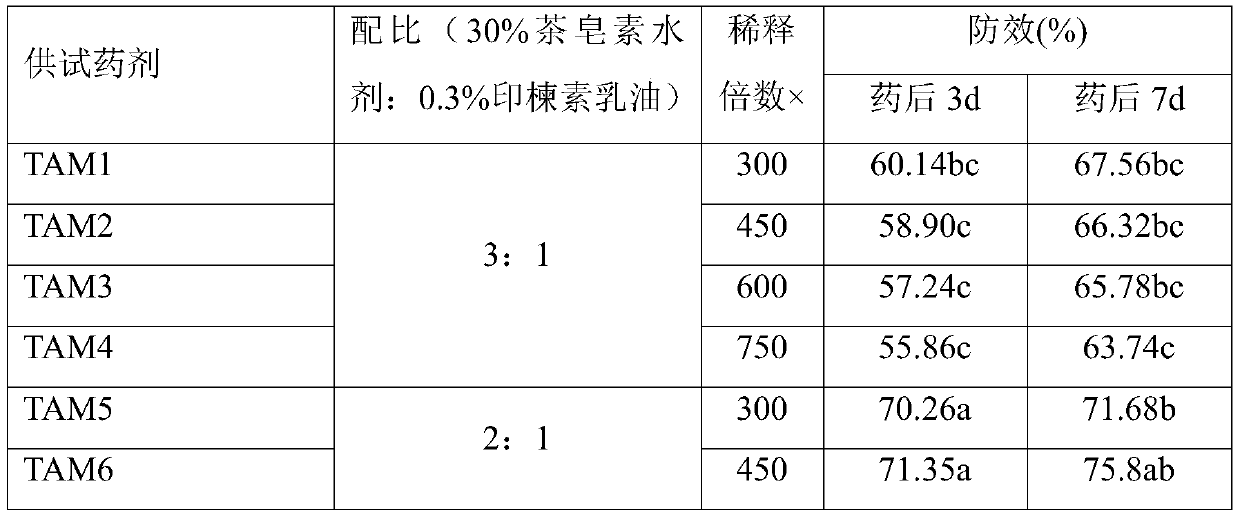Botanical mixed insecticide and application thereof
A technology of pesticides and botanical sources, applied in the field of botanical mixed pesticides, can solve the problems of inability to meet the needs of field control of tea leafhoppers, high requirements for pesticide application conditions, and low pest control effects, and achieve good results. Social benefit, improvement of control effect, effect of reducing usage
- Summary
- Abstract
- Description
- Claims
- Application Information
AI Technical Summary
Problems solved by technology
Method used
Image
Examples
Embodiment 1
[0019] Example 1 The control effect test of tea saponin and azadirachtin in different proportions and dilution combinations against the green leafhopper
[0020] The test of this embodiment was carried out in a tea farm in Guanya Town, Shiyan City, Hubei Province, and the control object was the small green leafhopper. The tested insecticides were 30% tea saponin aqueous solution and 0.3% azadirachtin EC mixed in 5 ratios of 3:1, 2:1, 1:1, 1:2 and 1:3. All ratios were diluted 4 times: 300×, 450×, 600× and 750×. A total of 5×4=20 treatment combinations were numbered TAM1, TAM2-TAM20 respectively. See Table 1 for the preparation of the control pesticides and their concentrations.
[0021] Plot arrangement and spraying method: The plots are arranged in random blocks, and the plot area is 20m2 2 , repeat 3 times. Apply the medicine during the high incidence period of green leafhopper in tea. Use a knapsack sprayer (model: 3WF-3A) to evenly spray the middle, upper and sides of ...
Embodiment 2
[0031] Example 2 Field control test and effect of preventing and controlling the small green leafhopper of tea
[0032] The experiment of this example was carried out in the tea base of the Tea Research Institute of the State Academy of Agricultural Sciences in Enshi City, Hubei Province, and the control object was the small green leafhopper. The tested pesticide is the invention product TAM6. The control insecticides and their concentration preparations are shown in Table 2.
[0033] Plot arrangement and spraying method: The plots are arranged in random blocks, and the plot area is 20m2 2 , repeat 3 times. Apply the medicine during the high incidence period of green leafhopper in tea. Use a knapsack sprayer (model: 3WF-3A) to evenly spray the middle, upper and sides of the tea pod to the tip of the leaves to form water droplets. Use 2 sprays. Apply again 7 days after the first application. No other pesticides were used to control pests and diseases during the experiment...
Embodiment 3
[0038] Example 3 Field control test and effect of preventing and controlling tea thrips
[0039] The experiment of this embodiment was carried out in the tea base of Tea Research Institute, State Academy of Agricultural Sciences, Enshi City, Hubei Province, and the control object was tea thrips. The tested pesticide is the product of this invention, and the control pesticide and the concentration preparation are shown in Table 3.
[0040] Plot arrangement and spraying method: The plots are arranged in random blocks, and the plot area is 20m2 2, repeat 3 times. In June 2019, it was applied during the high incidence of tea thrips. Use a knapsack sprayer (model: 3WF-3A) to evenly spray the middle, upper and sides of the tea pod to the tip of the leaves to form water droplets. 2 applications, and another application 7 days after the first application. No other pesticides were used to control pests and diseases during the experiment.
[0041] Investigation method, time and fre...
PUM
 Login to View More
Login to View More Abstract
Description
Claims
Application Information
 Login to View More
Login to View More - R&D
- Intellectual Property
- Life Sciences
- Materials
- Tech Scout
- Unparalleled Data Quality
- Higher Quality Content
- 60% Fewer Hallucinations
Browse by: Latest US Patents, China's latest patents, Technical Efficacy Thesaurus, Application Domain, Technology Topic, Popular Technical Reports.
© 2025 PatSnap. All rights reserved.Legal|Privacy policy|Modern Slavery Act Transparency Statement|Sitemap|About US| Contact US: help@patsnap.com



